If it’s your first time using a griddle for cooking salmon, you might be a little hesitant as you try to figure out how to go about it, what temperature to use, how long to cook your fish, and the exact procedure to follow.
Worry not, though. The following guide is a compilation of expert answers to the most common questions you might have in your mind regarding cooking salmon on the griddle.
1. Can you cook salmon on a griddle pan?
It is not only possible to cook salmon on a griddle pan, but it’s also an easy task for you. The griddle offers you a healthy way to cook your fish as you don’t need to use a high amount of oil.
For perfectly griddled salmon in a couple of minutes, you just ensure you use the correct heat setting and follow the proper steps.
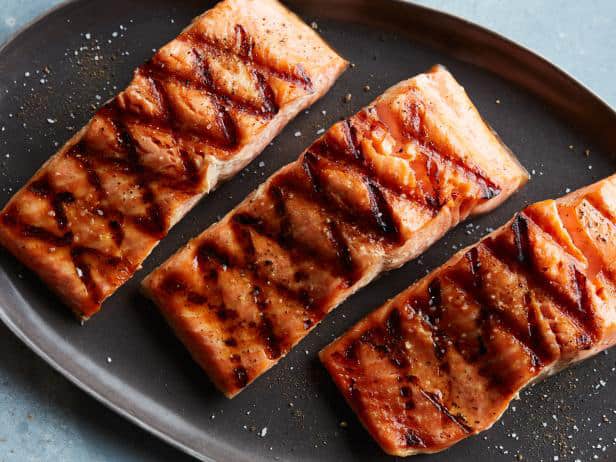
If you have an electric griddle, it becomes even easier for you to cook salmon because of this appliance’s ability to maintain a consistent and even cooking temperature—ensuring you get perfectly griddled salmon.
But this isn’t to say that a regular stovetop griddle won’t cook your fish. As long as you maintain constant heat, it will also cook your fish as evenly as the electric griddle.
2. What temperature do you cook fish on a griddle?
The ideal temperature range for cooking salmon on the griddle is Medium-High. If you have an electric griddle that lets you set the temperature, you should set it to 375 degrees Fahrenheit; this is the equivalent for medium-high heat.
Remember that you should pre-heat your griddle at this temperature before you put your salmon on it. DON’T put the fish on a cold griddle cooking surface unless you want to have an awful fish griddling experience.
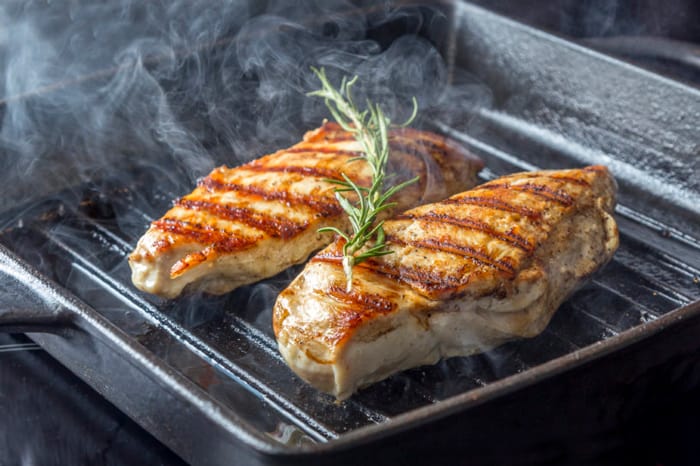
An easy trick to check whether your griddle is at medium-high temperature is adding a drop of water. If the water sizzles and septets instantly, the griddle is ready to go.
3. How do you cook salmon on the griddle?
Before you start cooking salmon on the griddle, you should familiarize yourself with the basics involved. This way, you’ll ensure you end up with well-cooked salmon.
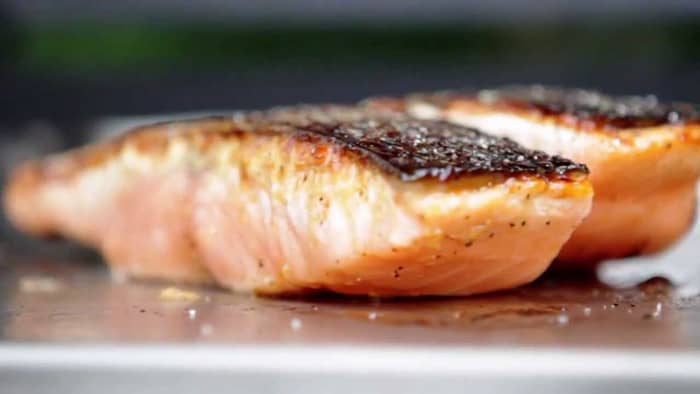
The following basic steps will help you griddle salmon like a pro:
Step 1. Season the salmon
The first step in griddling salmon is to season it. But we suggest that you first pat your salmon with clean paper towels to dry it and remove any blood spots and stray scales.
Afterward, season both sides of the fish with salt and pepper. Gently pat the seasoning into the fish as well. You can also use any other spice rubs of your choice.
After seasoning the fish, make sure you thoroughly wash your hands with soap and water.
Step 2. Prepare the griddle
Next, you’d want to coat your griddle with a light layer of your cooking oil. Though this is optional, oiling your griddle will help keep your fish from sticking on the surface. You can use any non-stick oil. Some folks recommend olive oil as it adds some flavor.
Fire up your griddle and pre-heat it to Medium-high temperature to prepare it for cooking. If you put a drop of water on your griddle and it spits and sizzles, it means your griddle is ready to cook the salmon.
Step 3. Put the salmon on the griddle
Place your salmon on the griddle such that the skin side is in contact with the cooking surface. Let it cook for about three-five minutes.
Then, using a spatula or a pair of tongs, flip the fish so that the skin-free side now becomes contact with the griddling surface. Let this side for three-five minutes as well.
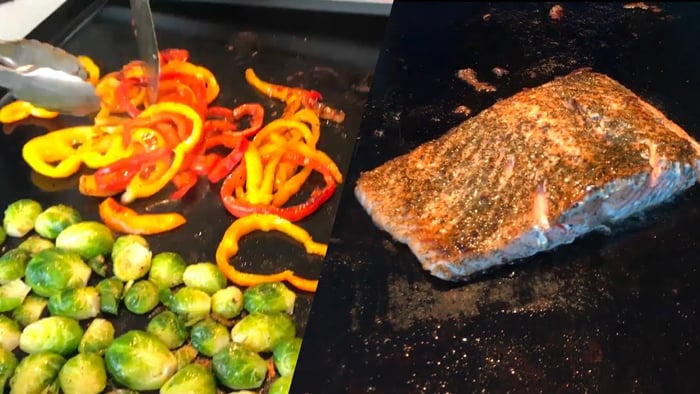
TIP: Avoid using a fork to turn your fish as it tends to break when cooked.
Step 4. Season it with a spice of your choice
As the skin side cooks, you might consider seasoning the now cooked skin-free side with additional flavorings. You may want to sprinkle lemon juice on the fish, but make sure it doesn’t get on the hot griddle surface. You can also use dried herbs to add flavor to your fish.
Step 5. Your salmon is ready!
After the skin side of the fish has been cooked for three-five minutes, your salmon is now ready. Perfectly cooked salmon features an opaque appearance and flakes easily with a fork.
Turn off the griddle and get your fish off the cooking surface. Let it rest for two to three minutes before serving. It allows it to finish cooking without getting dry or overcooked.
4. How long do you cook salmon on the griddle?
You should cook a regular-sized salmon on the griddle for not more than 10 minutes. Let one side of the salmon cook for three-five minutes. Flip the fish over and let the other side cook for another three-five minutes. That makes a total cooking time of approximately 10 minutes.
What if you’re worried about getting your salmon off the griddle before it’s done cooking? Well, in this case, you can use a more accurate method (the 10-minute rule) to estimate the cooking time.
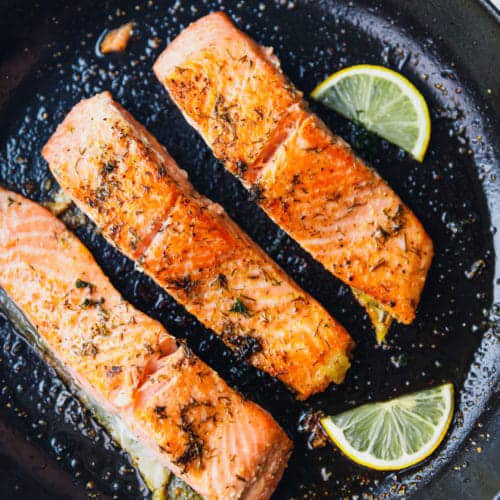
This is the 10-minute rule:
For every inch of salmon, you should cook it for 10 minutes. Don’t get it? Here’s an example. If you have a 1-inch thick salmon stick, you should cook each side of it for 5 minutes, which equates to a total of 10 minutes. You determine how thick the salmon is and let every inch of thickness cook for a total of 10 minutes.
If you have a fish below 1-inch, say ½-inch thick, you don’t have to flip it as it can cook through by just placing it on the griddle on one side.
For unthawed frozen salmon, double the total cooking time.
If you’re cooking your salmon in foil or sauce, you should give it an additional 5 minutes to cook through.
5. How do you know when salmon is finished?
The FDA recommends that fully cooked salmon should have an internal temperature of 145 degrees Fahrenheit. Of course, you’ll need to use a meat thermometer to get the temperature readings of the fish.
When it’s well cooked, salmon tends to change its appearance from translucent pink to opaque.
You can also gently press down on the top of the fillet with the help of a fork or finger. If it flakes (separates) easily along the white lines running across fillets, it’s done cooking!
However, checking the internal temperature of fish remains the most accurate method of determining if it’s cooked.
NOTE: If you’re done cooking the salmon, you should take it off the griddle immediately. Letting the fish cook any further will cause it to dry out and crumble when you start cutting it.
6. How to cook frozen salmon on the griddle?
If you crave salmon but don’t have time to thaw it, you can go ahead and griddle it straight from frozen. But the process here is slightly different from cooking fresh salmon and will take a little longer for your frozen salmon to cook through.
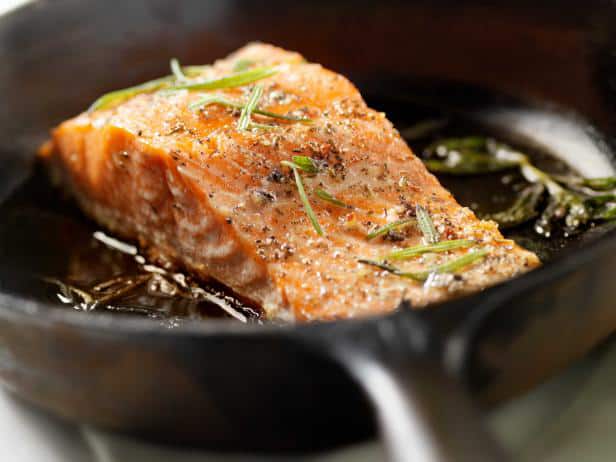
Cooking frozen salmon on the griddle:
Step 1. Season your salmon
Just like in the unfrozen salmon case, you should start by impairing flavors to your frozen salmon. Season it with salt and pepper. You can also use additional flavorings like dry rubs, glazes, sauces, etc.
If you go with dry rubs, be sure to press them into both sides of your fish. You can also apply them with some oil if you want to.
Step 2. pre-heat the griddle
Next, spray your griddle with high-temperature cooking oil. Applying oil on the surface will prevent the salmon from sticking on the griddle surface.
Then, pre-heat it to medium-high heat (or 375 degrees F). It is the ideal temperature to allow your fish to char while remaining moist on the inside.
Step 3. Put the fish on the griddle
Put your salmon on the hot griddle surface, with the skin side down. Since you’re dealing with a frozen fish, you’ll need to give it extra time to ensure it thoroughly cooks through.
If you’re using the more minor six-ounce cuts we recommended, let them cook for four-five minutes. The thicker and larger your fish fillets, the more cooking time you should budget for them.
Step 4. Flip the salmon
After the skin side has fully cooked, now turn your salmon with a pair of tongs or spatula to allow the skin-free side to cook as well. Give this side the same amount of time as the other side for a perfectly cooked salmon.
Step 5. Check if your salmon is fully cooked
A well-cooked salmon should transform from a translucent pink to an opaque appearance. If it’s well-cooked, it should also be able to flake easily with a fork.
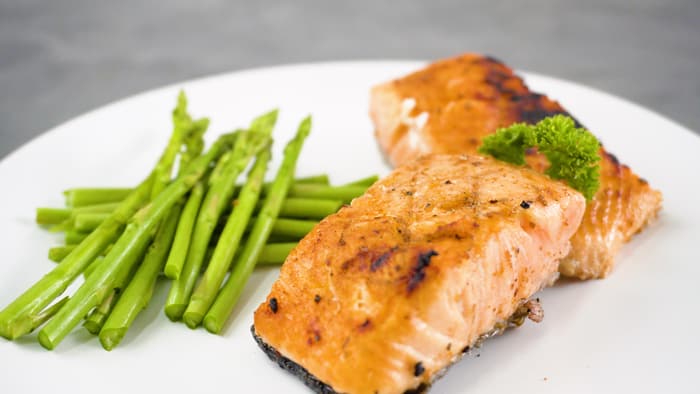
Additional tips for salmon from the freezer:
Tip #1. Cook it in a foil packet
If you want to grill your frozen salmon, this trick can help impart more flavors for a more delicious treat. Wrap the frozen salmon fillets in foil packets carrying your preferred flavorings, e.g., lemon, butter, herbs, spices, etc.
Wrap the foil tightly and place it on the grill. Let it cook for 10-12 minutes as you continue adjusting the time depending on the size of your fish fillets.
Tip #2. Work with smaller pieces
To enable your salmon to cook through and char evenly, consider working with more minor cuts. We suggest roughly fillets of roughly six ounces. The top sides of salmon might give you a challenging time cooking through.
7. Do you cook salmon on the grill skin side up or down?
You should start with the skin side down and let it cook for three-five minutes before you flip over to the skin-free side. A hidden advantage of griddling the skin side first is that it becomes easier to slide a spatula under it than the delicate, flesh side.
While some people might advise you to get off the skin from your salmon, we don’t recommend you to do it. The skin is quite tasty, plus it offers a layer of protection between the delicate flesh of your fish and the hot griddle.
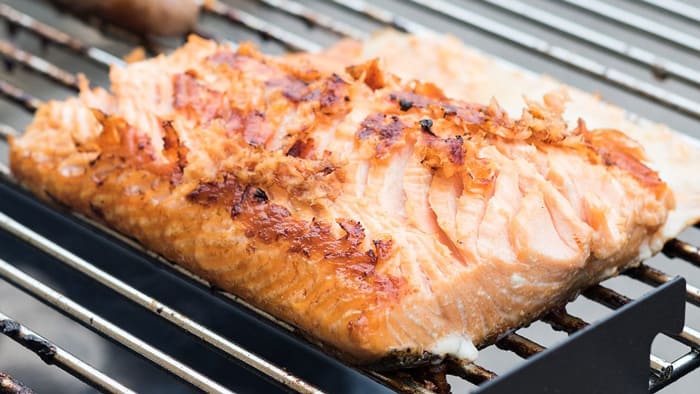
However, you’d want to remove the skin if you’re slow-roasting or poaching salmon. The skin won’t get crispy in liquid and will develop an unpleasant, gummy texture instead.
Final verdict
Cooking salmon on the griddle is pretty straightforward, and you can do it without prior experience. The secret to cooking delicious salmon on your griddle lies in learning all the tips and tricks of the cooking process. Now that we have answered all your questions related to cooking salmon on the griddle, you should have enough inspiration to get you started working on your favorite salmon recipe.

